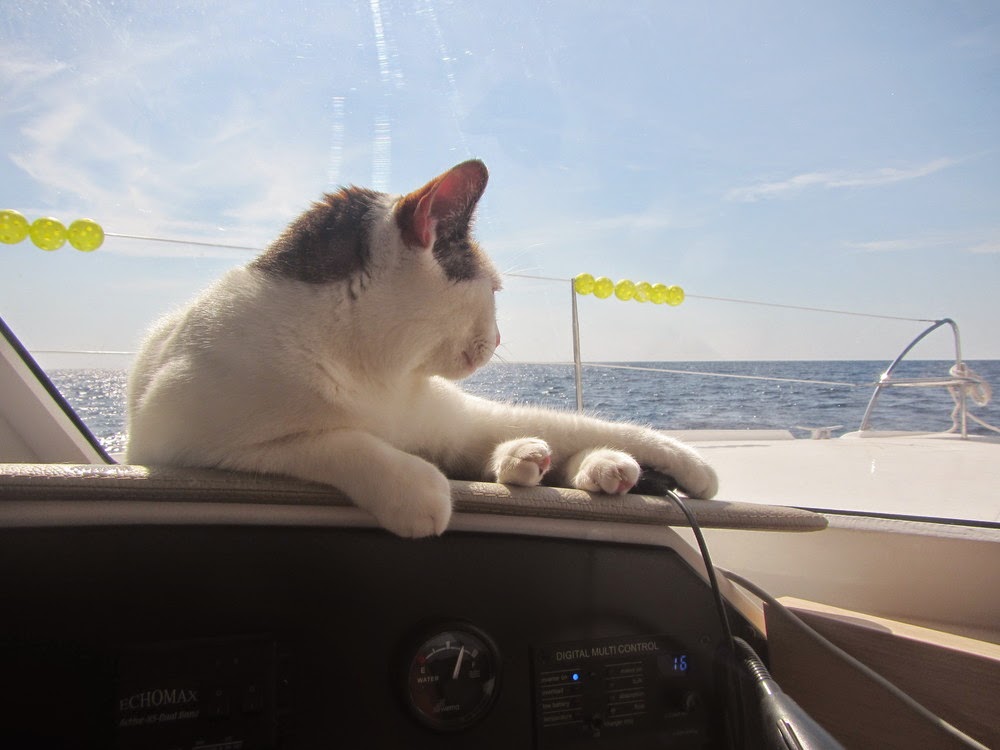3
O'clock in the morning. A peaceful scene, with
2 humans, and two cats piled on the bed, in deep sleep. On the deck
the storm is raging. The peace is quickly disturbed by the anchor
alarm emitting its loud “Beep, beep beep....”. It is my belief,
nothing wakes you up faster and with more clarity of mind than an
anchor alarm going off in a storm. Not even a triple espresso, with a
red-bull thrown in will have the same effect. Of course this has to happen at 3 in the morning, a time when the sleep
is deepest. After so many
false alarms, we did not expect this one to be real. After all,
outside it was blowing a “mere” 35-40 knots of wind. Nothing for
the likes of Excalibur. After confirming on the navigation laptop
that we were indeed dragging, we decided to get the anchor back up.
At this point we were 200 meters from the lee shore rocks, pounded by
an inviting surf. The distance between where the anchor was dropped,
and the location where the anchor was finally retrieved was 400
meter. This can be broken
down in: 100 meters for the alarm to be triggered. 200 meters for us
to wake up and decide to get the anchor up, and 100 meters for the
actual anchor retrieval.
When
Excalibur was finally up, with it came a large chunk of mud and weed.
Excalibur never relinquished it's death grip on the soil, it was the
soil being to weak to hang on to
itself. As this all happened, the water under the SaltyPaws was lit up by bioluminescence, as the water was running below the hulls.
 |
| Examining what happened from our track in the bay |
How could this have happened? We anchored at an “official”
anchorage, marked on the map. The anchor was dropped in 10 meters of
water, with 60 meters of scope. When we dropped the anchor, the water
was too murky, so we did not have the chance to select an inviting
sandy patch, or to snorkel over the anchor to check it was set. And
if we would have snorkeled over the anchor, we would have found an
anchor that was set.
We tried to re-anchor in the same bay, close to the original
location. In the second attempt, the anchor did not set at all, a
first for Excalibur. In the same bay there was a Dutch boat, that
also experienced anchor drag at the same time as we did. The holding
in this bay was simply not up to 40 knots of wind, even with a
massive anchor. Strange that this bay made it's way into the anchor
symbols on the map.
We moved to the next bay, which was also filled with the sound of
strained anchor winches of ships re-anchoring. We dropped Excalibur
in 16 meters of water. After our previous experience, we decided to
chase it with the full 100 meters of chain. This time was more in
line with our usual anchor experience: Excalibur set in no-time, and
held firm, even in the highest wind gust of 52.1 knots. We reset the
anchor alarms, and after a cup of tea, we went back to bed.
When we woke up the next morning, the sea could not be more calm.
Anyone on the beach would not have believed our story was it not for
the viable storm damage. A catamaran in our bay, on the beach lost
it's mast. A mono hull in the same bay blew out it's Genoa. It was
really 52.1 knots out there after all, and when fed with a clean
sand, Excalibur did not disappoint the second time around.
 |
| This yacht suffered a ruined genoa due to the storm |
 |
| The water the day after the storm could not be more calm |
 |
| More boats have entered the large sheltered bay to ride out the storm |

























